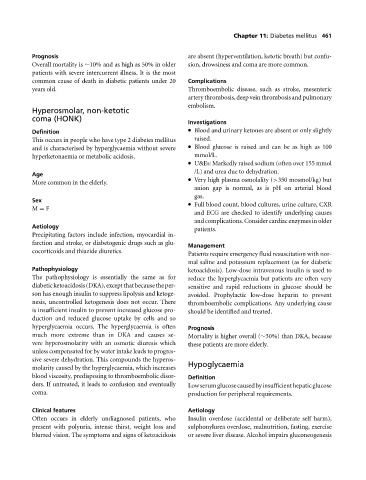Page 465 - Medicine and Surgery
P. 465
P1: FAW
BLUK007-11 BLUK007-Kendall May 25, 2005 8:5 Char Count= 0
Chapter 11: Diabetes mellitus 461
Prognosis are absent (hyperventilation, ketotic breath) but confu-
Overall mortality is ∼10% and as high as 50% in older sion, drowsiness and coma are more common.
patients with severe intercurrent illness. It is the most
common cause of death in diabetic patients under 20 Complications
years old. Thromboembolic disease, such as stroke, mesenteric
arterythrombosis,deepveinthrombosisandpulmonary
embolism.
Hyperosmolar, non-ketotic
coma (HONK)
Investigations
Definition Blood and urinary ketones are absent or only slightly
This occurs in people who have type 2 diabetes mellitus raised.
and is characterised by hyperglycaemia without severe Blood glucose is raised and can be as high as 100
hyperketonaemia or metabolic acidosis. mmol/L.
U&Es: Markedly raised sodium (often over 155 mmol
/L) and urea due to dehydration.
Age
Very high plasma osmolality (>350 mosmol/kg) but
More common in the elderly.
anion gap is normal, as is pH on arterial blood
gas.
Sex
Full blood count, blood cultures, urine culture, CXR
M = F
and ECG are checked to identify underlying causes
and complications. Consider cardiac enzymes in older
Aetiology
patients.
Precipitating factors include infection, myocardial in-
farction and stroke, or diabetogenic drugs such as glu- Management
cocorticoids and thiazide diuretics.
Patients require emergency fluid resuscitation with nor-
mal saline and potassium replacement (as for diabetic
Pathophysiology ketoacidosis). Low-dose intravenous insulin is used to
The pathophysiology is essentially the same as for reduce the hyperglycaemia but patients are often very
diabeticketoacidosis(DKA),exceptthatbecausetheper- sensitive and rapid reductions in glucose should be
son has enough insulin to suppress lipolysis and ketoge- avoided. Prophylactic low-dose heparin to prevent
nesis, uncontrolled ketogenesis does not occur. There thromboembolic complications. Any underlying cause
is insufficient insulin to prevent increased glucose pro- should be identified and treated.
duction and reduced glucose uptake by cells and so
hyperglycaemia occurs. The hyperglycaemia is often Prognosis
much more extreme than in DKA and causes se- Mortality is higher overall (∼30%) than DKA, because
vere hyperosmolarity with an osmotic diuresis which these patients are more elderly.
unless compensated for by water intake leads to progres-
sive severe dehydration. This compounds the hyperos- Hypoglycaemia
molarity caused by the hyperglycaemia, which increases
blood viscosity, predisposing to thromboembolic disor- Definition
ders. If untreated, it leads to confusion and eventually Lowserumglucosecausedbyinsufficienthepaticglucose
coma. production for peripheral requirements.
Clinical features Aetiology
Often occurs in elderly undiagnosed patients, who Insulin overdose (accidental or deliberate self harm),
present with polyuria, intense thirst, weight loss and sulphonylurea overdose, malnutrition, fasting, exercise
blurred vision. The symptoms and signs of ketoacidosis or severe liver disease. Alcohol impairs gluconeogenesis

